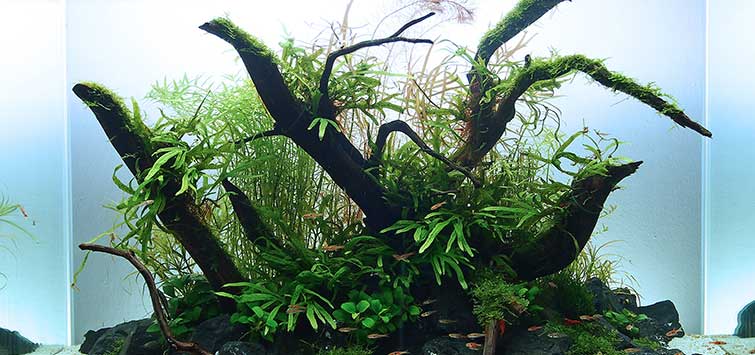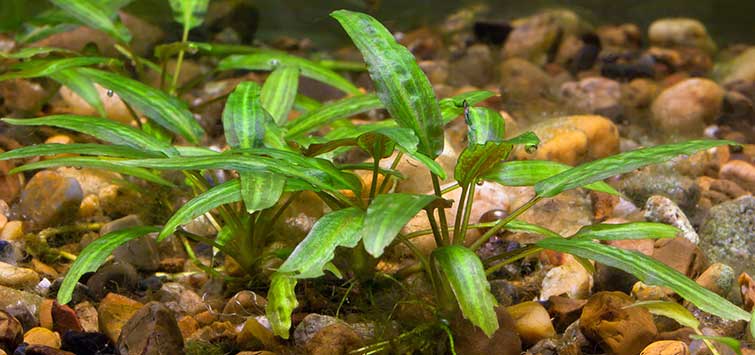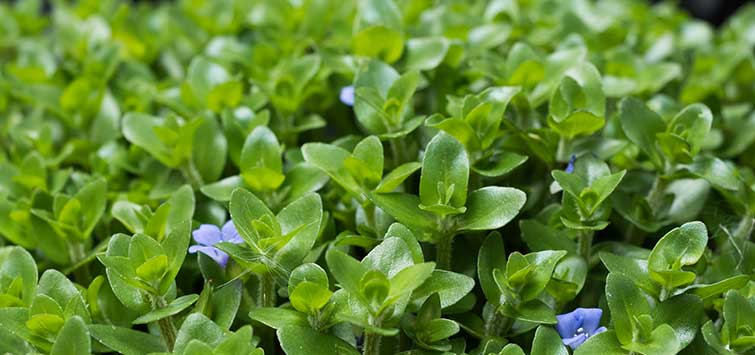Maintaining Shade-Loving Plants in the Nature Aquarium
Author: Takashi Amano
The genius of the planted aquascape discusses the upkeep of ferns, mosses, and other shade-loving plants for the long-term enjoyment of the Nature Aquarium layout.
Last month I discussed the trimming method for relatively fast-growing aquatic plants such as stem plants and foreground plants in the Nature Aquarium. This month I will explain the proper maintenance methods for shade-loving plants such as ferns, mosses, and the plants in the genera Cryptocoryne and Anubias.
Using Shade-Loving Plants in Your Layout
Shade-loving plants are often used in the middle ground of a layout, attached to a composition material such as driftwood or rocks or planted around the composition material. They form a group of plants that are indispensable for the Nature Aquarium. Shade-loving plants are often used in a layout where a large number of light-loving plants such as stem plants are used. It is actually rare to find a layout solely composed of light-loving plants. Shade-loving plants come in deep subdued colors such as dark green and brown. They produce a nice contrast against bright colored light-loving plants, and they can sharpen the visual impression of a layout.
Be Prepared for Slow and Steady Growth
Shade-loving plants tend to grow more slowly when compared to the quick-growing light-loving plants. When a layout is first set up, light-loving plants project a strong presence due to their vigor. As the layout is maintained over a long period of time, however, light-loving plants lose some of that vigor. On the contrary, shade-loving plants become dense with leaves and start to increase their presence over time. One of the reasons that shade-loving plants are often used is that we can enjoy such a change in a layout just as scenery changes in nature with the seasons.
Shade-loving plants are also useful for the middle ground when stem plants are planted in the background. As stem plants grow, they lose the leaves on the lower parts of their stems, making their lower portions quite unsightly. The lower part of the stem plants can be hidden effectively if the middle ground is planted with shade-loving plants that grow slowly and therefore change very little. When stem plants are trimmed and a layout temporarily lacks aquatic plants, it is still worth a look if shade-loving plants remain in the middle ground. Because of the reasons listed above, shade-loving plants are often used in the middle ground in the Nature Aquarium.
Trimming Shade-Loving Plants
Since shade-loving plants grow relatively slowly, they do not require frequent care. However, while their growth may be inconspicuous, they do grow steadily. You may find their leaves unexpectedly growing up against a glass surface, overwhelming the space. Large leaves of Bolbitis and Cryptocoryne need to be cut off near the bases of their leaves before they destroy the balance of a layout, as they can grow surprisingly large. Their leafstalks also grow long if leaves are allowed to grow big, making them appear sparse near their bases. Cutting old leaves encourages the plant to grow new leaves, making the plant appear fuller.
Cryptocoryne spreads by an underground stem off of which new plants are formed. The new plant tends to come out away from the original plant, and it may spoil the layout. Such a new plant needs to be cut off from the subterranean stem and relocated to a more suitable area.
Anubias is also used by attaching it to driftwood and rocks, just like ferns such as Bolbitis. Since Anubiasgrow even more slowly, it takes a very long time for the plants to recover if too many of their leaves are cut off. Therefore, at most, only yellowing and algae-infested leaves should be removed. Since black beard algae tends to grow at the edge of the leaves, and green spot algae can also grow on them, I recommend adding Siamese flying foxes and Otocinclus to an aquarium early on to control these algae issues.
Maintaining Mosses
Mosses, especially willow moss, are one of the most frequently used shade-loving plants in the Nature Aquarium. Mosses are suitable for expressing a natural serene atmosphere and the passage of time, which ties in to the artistic concept of wabi-sabi, a Japanese aesthetic centered on an appreciation of the imperfection and impermanence of the natural world.
Since willow moss tends to grow firmly attached to an object, it is used to cover the surfaces of driftwood and rocks. However, it requires a special technique to maintain it in good condition. Willow moss should first be spread thinly over the surface of driftwood or rock and secured with an inconspicuously colored cotton thread. As the moss grows, some of the fronds tend to stick out. These stray fronds should be carefully removed with scissors.
When the moss grows into a thick mat, the lower part where light does not penetrate will deteriorate. Therefore, the top portion should be removed manually before the moss gets too thick to allow light to reach the portion that has grown attached to the surface. After tearing the moss by hand, the part that sticks out should be trimmed off with scissors. By repeating this procedure, willow moss will grow into a beautiful thin layer, securely attached to the driftwood surface.
If willow moss does not attach well to the surface, it should be trimmed with scissors on the surface rather than torn off by hand to allow it to form into a nice layer. The method to use for controlling the growth of a moss—either cutting it with scissors or tearing off by hand—will vary depending on the condition of its attachment.
See the full article on TFH Digital http://www.tfhdigital.com/tfh/200711/#pg84

.png?h=595&iar=0&w=2781&hash=5FD5E69473BCC22199FBFA2FB71B6033)



